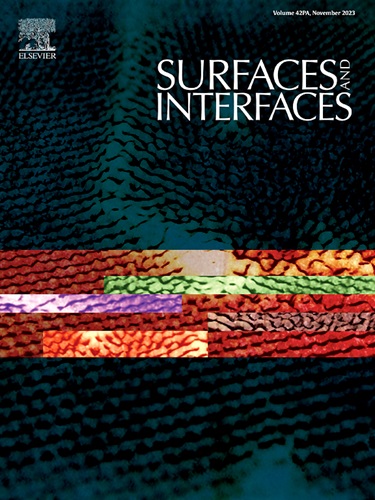界面电子调控促进了NiCo-LDH/Ce(OH)3异质结构在Cu(OH)2纳米线上对整体水分解的催化活性
IF 5.7
2区 材料科学
Q2 CHEMISTRY, PHYSICAL
引用次数: 0
摘要
氢作为一种优质的可再生能源,可以通过水电解技术帮助实现碳中和的目标。本文采用原位生长和化学刻蚀技术,在超亲水性Cu(OH)2纳米线上制备了NiCo-LDH/Ce(OH)3异质结构。Ce原子的引入实现了元素在nico - mof中的重新分配,由此产生的NiCo-LDH/Ce(OH)3中空纳米笼有助于实现最佳的比表面积和孔隙率。密度泛函理论(DFT)进一步揭示了NiCo-LDH/Ce(OH)3异质结构在界面处的电子调控行为。纳米线通过提供良好的化学环境来稳定异质结构。作为双功能催化剂,Cu(OH)2NiCo/Ce HS/CF具有优异的电催化性能和较低的电解能耗。在10ma cm-2时,HER和OER的过电位仅为126mv和219mv。此外,在模拟工业电解的条件下,Cu(OH)2NiCo/Ce HS/CF可以在800 mA cm-2下连续电解600 h。本研究为水电解领域先进双功能异质结催化剂的结构设计和电子调控提供了新的视角。本文章由计算机程序翻译,如有差异,请以英文原文为准。
Interfacial electronic regulation promotes the catalytic activity of NiCo-LDH/Ce(OH)3 heterostructures on Cu(OH)2 nanowires towards overall water splitting
As a high-quality renewable energy source, hydrogen can help to achieve the goal of carbon neutrality through water electrolysis technology. In this work, NiCo-LDH/Ce(OH)3 heterostructures were prepared on the super-hydrophilic of Cu(OH)2 nanowires by in-situ growth and chemical etching techniques. The introduction of Ce atoms achieved element redistribution in NiCo-MOFs, and the resulting NiCo-LDH/Ce(OH)3 hollow nanocages contribute to achieving an optimal specific surface area and porosity. Density functional theory (DFT) further reveals the electron regulation behavior at the interface caused by the NiCo-LDH/Ce(OH)3 heterostructures. Nanowires stabilize the heterostructures by providing a favorable chemical environment. As a bi-functional catalyst, Cu(OH)2![]() NiCo/Ce HS/CF demonstrated excellent electrocatalytic performance and low electrolytic energy consumption. The HER and OER’s overpotential is only 126 mV and 219 mV at 10 mA cm-2. Additionally, under conditions simulating industrial electrolysis, Cu(OH)2
NiCo/Ce HS/CF demonstrated excellent electrocatalytic performance and low electrolytic energy consumption. The HER and OER’s overpotential is only 126 mV and 219 mV at 10 mA cm-2. Additionally, under conditions simulating industrial electrolysis, Cu(OH)2![]() NiCo/Ce HS/CF can undergo continuous electrolysis for 600 h at 800 mA cm-2. This research offers new perspectives on the structural design and electronic regulation of advanced bifunctional heterojunction catalysts in the field of water electrolysis.
NiCo/Ce HS/CF can undergo continuous electrolysis for 600 h at 800 mA cm-2. This research offers new perspectives on the structural design and electronic regulation of advanced bifunctional heterojunction catalysts in the field of water electrolysis.
求助全文
通过发布文献求助,成功后即可免费获取论文全文。
去求助
来源期刊

Surfaces and Interfaces
Chemistry-General Chemistry
CiteScore
8.50
自引率
6.50%
发文量
753
审稿时长
35 days
期刊介绍:
The aim of the journal is to provide a respectful outlet for ''sound science'' papers in all research areas on surfaces and interfaces. We define sound science papers as papers that describe new and well-executed research, but that do not necessarily provide brand new insights or are merely a description of research results.
Surfaces and Interfaces publishes research papers in all fields of surface science which may not always find the right home on first submission to our Elsevier sister journals (Applied Surface, Surface and Coatings Technology, Thin Solid Films)
 求助内容:
求助内容: 应助结果提醒方式:
应助结果提醒方式:


